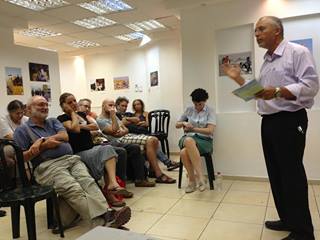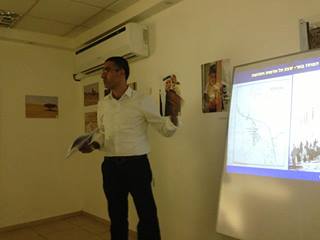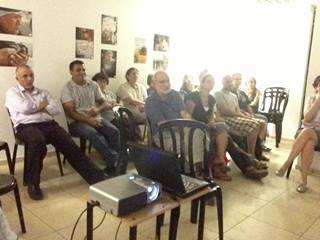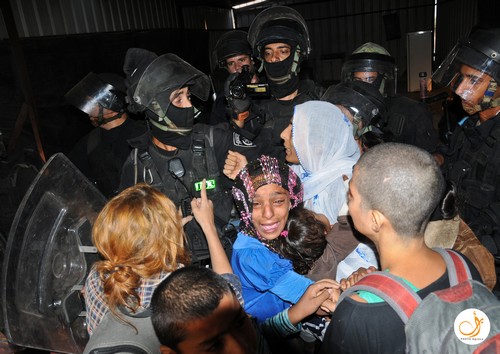27 August 2013. Twenty people attended. Moderator: Eitan Bronstein Aparicio.
Dr. Mansour Nasasra, Lecturer, University of Exeter. He studied the attitude of Ottoman, British and Israeli authorities to the question of Bedouin land ownership:
I studied land ownership by the Bedouin tribes in the Jordan Valley, Sinai and the Negev and the relations between those tribes and the modern state in the Middle East. I focused on the end of the Ottoman period, on the British Mandate and the 1950s and ‘60s, after Israel was established. I prepared a comprehensive mapping using archives in England, Israel and Jordan. The research showed that Bedouin owned land in an orderly and recognized manner. They were not, as Israel claims, landless nomads.
The British mapped the area of Palestine in 1881 and provided detailed information on the distribution of Bedouin tribes. The British mapped lands in 1913 and again documented the sites of Bedouin settlement in the area. In 1901 the Ottoman regime constructed its saraya (government offices) in Beersheba on land purchased from Azazma Bedouin. Documents in Istanbul provide evidence of Bedouin land ownership in the country. There’s documentation of a conflict between the Ottoman regime and the Tarabin Sheikh Hamad al Sufi, who was located in Beersheba, regarding land ownership.
Bedouin tax payments to the Ottoman authorities are documented in 1907. The British ambassador in Constantinople (Istanbul) testified that the Beersheba Bedouin pay land taxes. This evidence proves Bedouin owned land in the country. The British Mandate over Palestine from 1917 to 1948 recognized the tribal system and Bedouin land rights. In 1948 there were 90,000 Bedouin in the Negev.
Winston Churchill and Herbert Samuel met Bedouin leaders in Beersheba in 1921, indicating that the Mandate recognized Bedouin tribal law and land ownership.
In 2009 I interviewed Lord Oxford, who was the governor of Beersheba in 1943. He viewed Beersheba as belonging to the Azazma. He also said the British had no land settlement regime and adopted Ottoman laws. They recognized Bedouin land ownership without requiring its registration.
In 1940 the British Secretary of State, Malcolm MacDonald, confirmed that Bedouin in Beersheba paid taxes to the Mandatory authorities. British documents from 1947 report Bedouin agricultural activities, including planting fruit groves.
After the establishment of Israel, 9,000-12,000 Bedouin remained in the Negev, of the 90,000 who had lived there formerly. The others were uprooted, expelled from the country and not allowed to return. Those remaining were from the Azazma, Tayaha and Tarrabin.
A 1948 document from the Zionist Archives, written by the Military Governor, states that the Bedouin remaining are “friendly” and have been concentrated in the Sayag region which comprises 10% of the Negev’s area. The state tried to recruit some of them into the army. A military government was imposed on them; they were prohibited from leaving the Sayag area without permission from the military governor. UN reports indicate that many Bedouin left the country after the war also, and were not permitted to return.
Bedouin from 19 different tribes were concentrated in the Sayag. Of them, 14 were transferred or displaced there from other locations in the Negev. Bedouin from five tribes had originally lived in the area; they numbered 3,000 people. The military governor ordered that villages be established in the Sayag area for those displaced, but most of them still remain unrecognized today. In 1950-51 Israel collected 19,000 Israeli Lira in land tax from the Bedouin. Michael Hanegbi, the military governor of the Negev, was later forced to return the money so the payment would not constitute recognition by the state of Bedouin land ownership.
A committee headed by Yosef Weitz wrote in 1952: “The dispossession of Bedouin from their lands does not mean they don’t own them.” The committee concluded that Bedouin land ownership should not be recognized, even if it were proved they’d cultivated the land for a long period of time. Weitz himself prevented opening a land registry office in Beersheba. The committee recognized that Bedouin inhabited the Negev before the state was established.
In 1958, eleven Bedouin sheikhs from the Negev sent a letter to the government saying they’d received various promises and the time had come to discuss their land ownership. In response the state established a temporary committee to deal with ownership claims. The committee recommended that the Bedouin be given money in compensation for their land. In 1965 Bedouin in the Negev organized a meeting attended by hundreds of people, during which they met Prime Minister Levi Eshkol. In response the government established another official commission.
In my opinion, the problem of recognizing Bedouin land ownership goes back to the the 1858 Ottoman land laws. They were passed but not applied in the Jordan Valley, Sinai and the Negev, and the lands were not registered in their owners’ names.
Haya Noah, Director, Negev Coexistence Forum for Civil Equality, author of Villages That Are And Are Not:
I’d like to describe the process leading to the Prawer plan. Israel’s first step after 1948 was to concentrate the Bedouin in the Sayag area.
The second step, as the military government period was ending, was building towns and forced urbanization. As a result, about 125,000 of the 210,000 Negev Bedouin today live in towns. By the way, although some of them are registered as residing in Rahat, in fact they live in surrounding villages. According to the government, the purpose of urbanization was to repossess land, provide municipal infrastructure and prevent the unchecked expansion of Bedouin settlement into vast areas.
The third step was the registration of ownership claims. According to the 1969 Land Law, Bedouin are permitted to submit ownership claims. Claims were settled for 400,000 dunums; disagreement remained regarding 600,000, about five percent of the area of the Negev. Attorney Pliah Albek proposed a compromise in which 20% of the land of each claimant would be recognized, but only because of “humanitarian considerations,” not by right.
The government’s fourth step was to recognize eleven new localities. Though they were recognized ten years ago, electricity, sewage, water and other infrastructure has still not been completed. They have only access roads. These recognized villages have no Outline Plans, nor can their residents obtain construction permits, and the government demolishes buildings.
The fifth step comprised the establishment of various committees. The Goldberg Committee’s rhetoric was positive but its recommendations were bad. The government rejected them and appointed the Prawer Committee. There was also the Amidror Committee and the Begin Committee.
The sixth, current step is a draft law to regularize settlement whose goal is, in effect, to implement the Prawer recommendations.
The Prawer plan has two components: Land - compensation and relocation; Planning – organizing the settlement of relocated Bedouin. It’s not part of the draft law but is included in the outline plan for metropolitan Beersheba.
The draft law creates a problematic link between recognizing land ownership claims and planning. The draft law passed its first reading in the Knesset on 24.6.13. The law doesn’t contain “settlement solutions” – it only deals with settling ownership claims, punishment, etc. The law requires claims to be settled within three years. If no agreement is reached, the land passes to the state. The law addresses 50 percent of the cultivated or occupied land. In fact, it deals with less than 50 percent. Begin recommended an amendment giving 25 percent for uncultivated or unoccupied land. I don’t understand this sentence. Highway 40 serves as a barrier to the west; that is, land will be granted in compensation or localities established only to its east. Araqib, for example, lies west of Highway 40.
According to the Beersheba Metropolitan Outline Plan (2012), the Bedouin will be concentrated in the towns and recognized villages, or villages adjoining them (“touching their border”). New localities will be established only as a last resort. The criteria for establishing new localities require them to be located in a very limited “search area,” a critical locality size and municipal sustainability (tax base).
The proposed arrangement has many serious problems. It’s one-sided; most Bedouin oppose it. It ignores property rights and will dispossess the Bedouin from most of their land. In fact, all the unrecognized villages will be uprooted. The Bedouin will retain only 180,000-200,000 dunums. Land confirmed as being owned by a particular Bedouin will not necessarily be that on which lives. People will be relocated in order to avoid perpetuating ownership. The plan does not recognize historic rights other than “ex gratia.” The plan will result in demolition of villages and forced relocation. It is inequitable. It contains harmful sanctions, a sliding scale of compensation that diminishes as the amount of compensation increases. The arrangement is conditioned on cooperation with the government on the draft law.
The planning component is discriminatory and is not based on universalistic criteria. New villages will not be established on land historically owned by the Bedouin, but only in the “search area.” The government estimates that some 30,000 people will be relocated; professionals estimate the number to be approximately 70,000. Villages will be demolished, the village texture of life will be destroyed along with its economy and identity. The government is investing huge resources to sell the plan. For example, it is offering development programs to the towns slated to receive the relocated village population. The Jewish public doesn’t understand the plan and hasn’t anything to do with it. The Palestinians understand that it’s a second nakba. The organizations opposing the plan are small, poor and isolated.
Dr. Awwad Abu Freih, a member of the Al-Araqib Action Committee:
I come from the field, which is burning. Yesterday Sheikh Sayah from Al-Araqib and three additional residents were arrested during the 58th demolition in the village. It was the third during the past ten days. They’re still in jail.
I was born in Al-Araqib. I rode a donkey to school. Later I studied chemistry. I received my BA in Jerusalem and a doctorate from the Technion.
What is most important to us now is Tzumud, to remain steadfast. To continue living there, where we belong, in the face of all those who don’t want us to remain. In the face of the east wind, and the west wind, and the rain and the sun – to keep taking care of the children, to remain sane. We work in Jewish localities because there’s no work in the village. There’s almost no Bedouin agriculture in the Negev. Even the camel’s milk we drink is bought from Jews. We have water only for drinking and showers.
Bedouin have never uprooted trees. The JNF uprooted more than 10,000 trees in Al-Araqib. The bulldozer began with Sheikh Sayah. The struggle is local, in the Negev; countrywide, including Arabs in the north and Jews; and abroad, in Europe, Australia and at the UN.
Even though we’re the most weakened population in the state, today our struggle against it is more determined than anyone else’s. It’s hard to organize because our localities aren’t recognized, so we have no recognized council or committee. We must organize independently, spontaneously. There’s no single unifying leadership.
The legal struggle isn’t easy. I have a document indicating my grandfather bought the land from Al Oukbi. Ottoman and British stamps are affixed to it. When we come to claim the land the state tells us that it was expropriated and offers us compensation, or they tell us that it had been purchased from someone who wasn’t authorized to sell it. The court says we have no standing to sue.
We’re the only ones currently in court. The District Court judge decided I had no rights, without even seeing me. Another judge, who dealt with exactly the same matter, said there was a case, and it should be heard. I appealed to the Supreme Court, and the state appealed to the Supreme Court in the Sayah case. Three Supreme Court justices said we were right. There’s something to talk about, despite the expropriation law. The state got annoyed at the precedent and appealed for a hearing before a panel of seven justices. We’re awaiting the hearing. Meanwhile, a forest has been planted on our lands. The judge allowed the bulldozers to keep working on my land. All my land is now a forest. The Bedouin have never won a case in an Israeli court, which is why the struggle seems lost even before it’s begun.
The public struggle proceeds in a number of ways. Every Sunday there’s a demonstration at the Lehavim junction. Large demonstrations were held in Jerusalem, Tel Aviv and in the north. We have a Facebook page.
We’ve now been unrecognized for a number of generations. It’s painful. The state considers we have no connection to the land, the language, the dream, the future. We’re nothing. Our traditions tell us that when the Patriarch Abraham reached Beersheba, he found Bedouin. It’s hard to hear terms like “diaspora,” “unrecognized,” “taking over the Negev.” We’re struggling against being seen as thieves and criminals.
Prawer turned us into a hostile group which must be kept away from a main highway, from the borders of Gaza, from the borders of the West Bank, to concentrate us far from them all. A security functionary like Prawer, like Amidrur, is whom they consider appropriate to deal with us. The future building plan refers only to those alive today. Children aren’t considered, there’s no plan for the future. The options are urbanization or demolition. We don’t get to choose an area, like Jews do. Some Bedouin want to be farmers, but nobody even asks them. The unrecognized villages are like hostages. The municipal leaders can receive money from the state for development only on condition that they absorb the Bedouin displaced from their villages.
Questions and answer:
Yaakov Eitan: How do you live?
Abu Freih: Remaining steadfast is in my soul. We must remain human. Not hate even those who destroy our homes. Otherwise it’s truly not easy.
Michael Alexander: Are you Arabs or Palestinians? Are Bedouin Palestinians?
Abu Freih: We’re Arabs, Palestinians, Bedouin, Arabs of ’48. “Bedouin” is only a way of life. We’re an integral part of Arabs in Israel, fully Palestinian. Rahat, for example, is a Bedouin city because its inhabitants lived in the past as Bedouin. There are also Bedouin villages in the north, even though their way of life has changed.
Q: Does the UN recognize Bedouin as a native population?
Abu Freih: Not yet. We’re working on it, even though it could be a problem because some might say that it could harm Palestinians elsewhere in the country.
Q: How can this struggle be won? Here, or abroad?
Abu Freih: It’s easier now abroad. We sense the influence on the government of foreign reaction. But the current government is impervious. They’ll pass the law, but won’t be able to implement it. They’ll need a million bulldozers and a million soldiers to do so. It’s not clear the government will choose that route. When they see we overwhelmingly reject the law, and those who accept it are ostracized. The state is very skilled in “divide and rule.” We’re fighting that.

ד"ר עואד אבו פריח בזוכרות / Dr. Awad Abu Freih at Zochrot

ד"ר מנצור נסאסרה בזוכרות / Dr. Mansour Nsasra at Zochrot

דיון על תכנית פראוור / Diacussion on Praver plan



